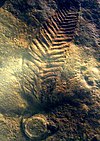| Arborea Temporal range: Ediacaran PreꞒ Ꞓ O S D C P T J K Pg N | |
|---|---|

| |
| Charniodiscus arboreus (=Arborea arborea) | |
| Scientific classification | |
| Domain: | Eukaryota |
| Kingdom: | Animalia |
| Phylum: | †Petalonamae |
| Class: | †Arboreomorpha |
| Genus: | †Arborea Glaessner, 1959 |
| Type species | |
| †Arborea arborea Glaessner, 1959 | |
| Species | |
| |
Arborea is a genus of petalonamid that was originally considered as being synonymous with Charniodiscus. It consisted of a frond-like body 3–4 inches (7.6–10.2 cm) long that was attached to the substrate via a holdfast that possessed many concentric rings on it. Species which were thought to have been within the genus Charniodiscus are now being interpreted as belonging to the genus Arborea with the latter of which being considered synonymous with Charniodiscus. A. arborea was first described from South Australia, and is the most abundant petalonamid in the Flinders Ranges. The genus currently contains 5 known species with 3 of them originally being species of Charniodiscus; the species include A. arborea, A. denticulata, A. longa, A. oppositus and A. spinosa.
See also
References
- Records of the South Australian Museum. Published under the authority of the board of governors and edited by the museum director. 1974.
- Fedonkin, Mikhail A.; Sciences), Mikhail A. (Head Fedonkin, Laboratory of Precambrian Organisms Russian Academy of; Gehling, James G.; Museum), James G. (Senior Curator Gehling, retired 6 27 2019 South Australian; Grey, Kathleen; Narbonne, Guy M.; Vickers-Rich, Patricia; University), Patricia (Director Vickers-Rich, Monash (Mar 16, 2007). The Rise of Animals: Evolution and Diversification of the Kingdom Animalia. JHU Press. ISBN 9780801886799. Retrieved May 11, 2022 – via Google Books.
{{cite book}}: CS1 maint: multiple names: authors list (link) CS1 maint: numeric names: authors list (link) - A Concise Dictionary of Paleontology: Second Edition. Springer. 18 October 2019. ISBN 9783030255862.
- ^ Pérez-Pinedo, Daniel; McKean, Christopher; Taylor, Rod; Nicholls, Robert; McIlroy, Duncan (2022). "Charniodiscus and Arborea Are Separate Genera Within the Arboreomorpha: Using the Holotype of C. concentricus to Resolve a Taphonomic/Taxonomic Tangle". Frontiers in Earth Science. 9: 1393. Bibcode:2022FrEaS...9.1393P. doi:10.3389/feart.2021.785929. ISSN 2296-6463.
- Dunn, Frances S.; Liu, Alexander G.; Gehling, James G. (2019). "Anatomical and ontogenetic reassessment of the Ediacaran frond Arborea arborea and its placement within total group Eumetazoa". Palaeontology. 62 (5): 851–865. Bibcode:2019Palgy..62..851D. doi:10.1111/pala.12431. hdl:1983/5677888d-1cd1-4e92-8aa8-57940f30626a. S2CID 134473478.
| Taxon identifiers | |
|---|---|
| Arborea | |
| Petalonamae | |||||||
|---|---|---|---|---|---|---|---|
| |||||||
| Arboreomorpha |  | ||||||
| Erniettomorpha | |||||||
| Rangeomorpha |
| ||||||
| Unclassified | |||||||
| Part of the Ediacaran biota | |||||||